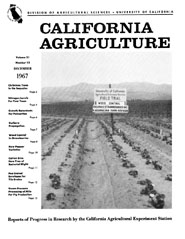


University of California
California Agriculture
|
|||
|
|||

University of California Agricultural Extension Service field trial: weed control, Salinas Strawberries, Inc.
December 1967
Volume 21, Number 12 |
|||
|
University of California, 1301 S. 46th St., Bldg. 478 Richmond, CA
|